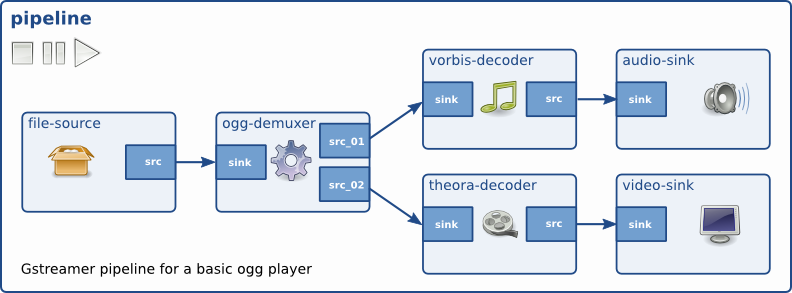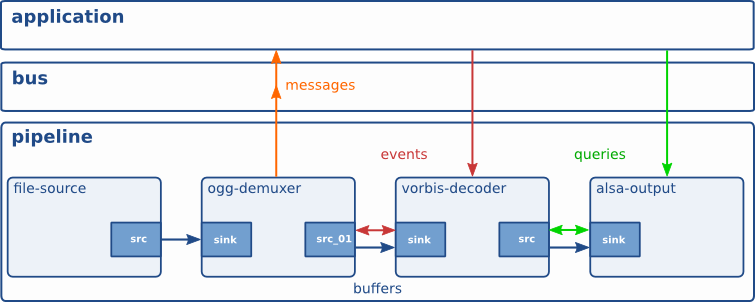os's Blog
Happy coding
Gstreamer design documents.
这是设计者写的原始设计文档,
多读几遍,结合代码来看。
http://cgit.freedesktop.org/gstreamer/gstreamer/tree/docs/design/

可见,pipeline的主要布局是elements, Bins 和pads.把上述几个对象继承关系牢记脑海中。PADs是连接器。pipeline的各对象之间的通信通过缓存buffers、事件event、查询query、消息message机制实现, 调度通过时钟clock和队列queue实现。

个人阅读顺序:
part-convertions.txt
part-overview.txt
初步对gstreamer的设计有个大致的了解。
part-gstelement.txt
GstElement 一般是从GstElementFactory中create, 为什么不直接用g_object_new()?
(工厂名,就是插件名, 所以需要加载插件,然后创建对应的Element)
GstPad也是从GstObject派生,和GstElement是并行的派生关系,
但是GstPad一般隶属于GstElement.
GstPad是GstElement的property, 在GstElement内部:用几个GList来保存GstPad.
part-element-source.txt
part-element-sink.txt
sink的设计要被source element复杂一些,都是实际使用的抽象。
现实中,sink就是比source复杂些。
part-element-transform.txt
根据user case分析内部的运行情况。
part-pads.txt 缺失
GstPad和GstPadTemplate是什么关系?
GstPadTemplate就是一个工厂吗?
push/poll模式
chain函数的作用?
part-caps.txt
caps其实是描述媒体类型(media type)的,用GstStructure保存;
caps似附属于gstPads/GstPadTemplate上的。
GstCaps是数据类型。
part-negotiation.txt
caps的negotiation: 规格的协商。
pipeline的各对象之间的通信通过缓存buffers、事件event、查询query、消息message机制实现, 调度通过时钟clock和队列queue实现。
part-buffering.txt
buffering的目的:缓冲数据,使得播放更平顺。
buffer包含由(内存指针,内存大小,时间戳,引用计数等信息)。简单的使用方式是:创建buffer,分配内存,放入数据,传输到后续element,后续element读数据,处理后减去引用计数。更复杂的情况是element就地修改buffer中的内容,而不是分配一个新的buffer。element还写到硬件内存(video-capture src等),bufer还可以是只读的。
part-bufferlist.txt
part-events.txt
Events are objects passed around in parallel to the buffer dataflow to notify elements of various events.
Events are received on pads using the event function. Some events should be interleaved with the data stream so they require taking the STREAM_LOCK, others don't.
Different types of events exist to implement various functionalities.
GST_EVENT_FLUSH_START: data is to be discarded
GST_EVENT_FLUSH_STOP: data is allowed again
GST_EVENT_EOS: no more data is to be expected on a pad. GST_EVENT_NEWSEGMENT: A new group of buffers with common start time GST_EVENT_TAG: Stream metadata.
GST_EVENT_BUFFERSIZE: Buffer size requirements
GST_EVENT_QOS: A notification of the quality of service of the stream GST_EVENT_SEEK: A seek should be performed to a new position in the stream GST_EVENT_NAVIGATION: A navigation event.
GST_EVENT_LATENCY: Configure the latency in a pipeline
* GST_EVENT_DRAIN: Play all data downstream before returning.
* not yet implemented, under investigation, might be needed to do still frames in DVD.
Event控制包,可以发送给上/下游element。发送给下游的event统治后续element流状态,是断绝,涮新,流结尾等信息。发送给上游event用在应用交互和event-event交互,用来请求改变流状态,例如seek等。对于应用来说,只有上流event比较重要。下流event仅仅维持一个完整的数据流概念。
typedef enum {
GST_EVENT_UNKNOWN = GST_EVENT_MAKE_TYPE (0, 0),
/* bidirectional events */
GST_EVENT_FLUSH_START = GST_EVENT_MAKE_TYPE (1, FLAG(BOTH)),
GST_EVENT_FLUSH_STOP = GST_EVENT_MAKE_TYPE (2, FLAG(BOTH) | FLAG(SERIALIZED)),
/* downstream serialized events */
GST_EVENT_EOS = GST_EVENT_MAKE_TYPE (5, FLAG(DOWNSTREAM) | FLAG(SERIALIZED)),
GST_EVENT_NEWSEGMENT = GST_EVENT_MAKE_TYPE (6, FLAG(DOWNSTREAM) | FLAG(SERIALIZED)),
GST_EVENT_TAG = GST_EVENT_MAKE_TYPE (7, FLAG(DOWNSTREAM) | FLAG(SERIALIZED)),
GST_EVENT_BUFFERSIZE = GST_EVENT_MAKE_TYPE (8, FLAG(DOWNSTREAM) | FLAG(SERIALIZED)),
GST_EVENT_SINK_MESSAGE = GST_EVENT_MAKE_TYPE (9, FLAG(DOWNSTREAM) | FLAG(SERIALIZED)),
/* upstream events */
GST_EVENT_QOS = GST_EVENT_MAKE_TYPE (15, FLAG(UPSTREAM)),
GST_EVENT_SEEK = GST_EVENT_MAKE_TYPE (16, FLAG(UPSTREAM)),
GST_EVENT_NAVIGATION = GST_EVENT_MAKE_TYPE (17, FLAG(UPSTREAM)),
GST_EVENT_LATENCY = GST_EVENT_MAKE_TYPE (18, FLAG(UPSTREAM)),
GST_EVENT_STEP = GST_EVENT_MAKE_TYPE (19, FLAG(UPSTREAM)),
/* custom events start here */
GST_EVENT_CUSTOM_UPSTREAM = GST_EVENT_MAKE_TYPE (32, FLAG(UPSTREAM)),
GST_EVENT_CUSTOM_DOWNSTREAM = GST_EVENT_MAKE_TYPE (32, FLAG(DOWNSTREAM) | FLAG(SERIALIZED)),
GST_EVENT_CUSTOM_DOWNSTREAM_OOB = GST_EVENT_MAKE_TYPE (32, FLAG(DOWNSTREAM)),
GST_EVENT_CUSTOM_BOTH = GST_EVENT_MAKE_TYPE (32, FLAG(BOTH) | FLAG(SERIALIZED)),
GST_EVENT_CUSTOM_BOTH_OOB = GST_EVENT_MAKE_TYPE (32, FLAG(BOTH))
} GstEventType;
static GstEventQuarks event_quarks[] = {
{GST_EVENT_UNKNOWN, "unknown", 0},
{GST_EVENT_FLUSH_START, "flush-start", 0},
{GST_EVENT_FLUSH_STOP, "flush-stop", 0},
{GST_EVENT_EOS, "eos", 0},
{GST_EVENT_NEWSEGMENT, "newsegment", 0},
{GST_EVENT_TAG, "tag", 0},
{GST_EVENT_BUFFERSIZE, "buffersize", 0},
{GST_EVENT_SINK_MESSAGE, "sink-message", 0},
{GST_EVENT_QOS, "qos", 0},
{GST_EVENT_SEEK, "seek", 0},
{GST_EVENT_NAVIGATION, "navigation", 0},
{GST_EVENT_LATENCY, "latency", 0},
{GST_EVENT_STEP, "step", 0},
{GST_EVENT_CUSTOM_UPSTREAM, "custom-upstream", 0},
{GST_EVENT_CUSTOM_DOWNSTREAM, "custom-downstream", 0},
{GST_EVENT_CUSTOM_DOWNSTREAM_OOB, "custom-downstream-oob", 0},
{GST_EVENT_CUSTOM_BOTH, "custom-both", 0},
{GST_EVENT_CUSTOM_BOTH_OOB, "custom-both-oob", 0},
{0, NULL, 0}
};
part-bus.txt
从pipeline线程向应用程序发送发送消息,目的是对应用屏蔽线程的概念。缺省情况下,每个pipeline包含一个bus,所以应用不需要创建bus,仅仅需要在bus上设定一个对象信号处理类似的消息处理。当主循环开始运行后,bus周期性的检查新消息,如果有消息,那么调用注册的回调函数。如果使用glib,那么glib有对应的处理机制,否则使用信号机制。
流过pipeline的数据由buffers和events组成。buffers中是确切的pipeline数据,events中是控制信息,比如seek信息,end-of-stream指示等。src-element通常创建一个新的buffer,通过pad传递到链中的下一个element。
2025年5月12日 14:12
MangaraやHitomi.laやHentaiサイトはウィルスやスパイウェアだらけで危険です。 hentai
===================================
話題の無料エロまんがを今すぐチェック!ジャンル別・人気順で探せる読み放題サイト。スマホ・PC対応で快適閲覧、毎日新作追加中。 無料エロまんが
===================================
【Hitomi、raw、Hentai等の無料エロ漫画は危険です。使用はやめましょう!】 hitomi
===================================
最新の無料エロ漫画を毎日更新中!話題の人気作品から定番ジャンルまで、高画質&スマホ対応でサクサク読める。今すぐチェック! 無料エロ漫画
===================================
MangarawやHitomi.laやHentai等の違法漫画サイトは危険です! hentai
===================================
mangarawやHitomi等の海賊版サイトはウィルスだらけで危険です! raw
===================================
人気の無料エロ漫画を高画質で今すぐチェック!ジャンル別・ランキング形式で厳選されたおすすめ作品を毎日更新中。スマホでもPCでも快適に閲覧可能。 無料エロ漫画
===================================
【Hitomi.laやMangarawやRawkumaはウィルスだらけで危険です!】 hitomi
===================================
素人エロ動画を厳選紹介!プロとは違うリアルな興奮や素朴な魅力が満載の人気素人作品を今すぐチェック。毎日更新で新作も見逃せない! 素人エロ動画
===================================
エロ同人の魅力を徹底解説!人気ジャンルやおすすめ作品、初めて読む方へのガイドまで、エロ同人の世界を深く紹介します。安全な読み方や楽しみ方のポイントも掲載。 エロ同人
===================================
話題のエロ漫画を無料で読めるおすすめサイトを厳選紹介!ジャンル別・作家別に探しやすく、スマホでも快適に閲覧可能。今すぐお気に入りの1冊を見つけよう! 無料エロ漫画
===================================
人気のフル漫画動画を無料で視聴!アクション・恋愛・ホラーなど多ジャンルの漫画動画が高画質で楽しめる。最新作から名作まで今すぐチェック! フル漫画動画
===================================
SNSやドラマで見かけた「あの女優は誰?」と気になるあなたへ。名前や出演作、プロフィールまで詳しくご紹介します! この女優は誰?
===================================
最新のエロ漫画を無料で楽しむならココ!話題作から隠れた名作まで、ジャンル豊富に取り揃え。登録不要&スマホ対応で今すぐ読める! 無料エロ漫画
2025年5月13日 17:35
瀬戸環奈のVR作品を徹底紹介!リアルな映像美と臨場感で話題の最新VR動画を一覧でチェック。没入感たっぷりの体験を今すぐ楽しもう。 瀬戸環奈 vr
===================================
エロ同人誌の人気作品から最新トレンドまでを徹底紹介。ジャンル別のおすすめや作家情報も掲載。初心者からコアなファンまで楽しめるコンテンツが満載! エロ同人
===================================
HitomiやRawなどの海賊版漫画サイトは、ウィルス感染や個人情報漏洩の危険性が高く非常に危険です。本記事ではそのリスクと、安全に漫画を楽しむための代替サービスについて解説します。 hitomi
===================================
スケベな本・エッチな漫画を毎日更新!無料で読める高画質&多ジャンルの大人向けコミックを厳選してご紹介。刺激的なストーリーを今すぐチェック! raw
===================================
芸能人にまつわる意外な豆知識や裏話、ちょっと笑えるエピソードを厳選してご紹介。知っていると話のネタになる情報が盛りだくさん! 芸能人 豆知識
===================================
最新の無料エロ漫画が今すぐ読める!ジャンル別・ランキングで人気作品をチェック。スマホ・PC対応、登録不要で快適に楽しめるエロマンガ特集。 無料エロ漫画
===================================
現役予想家が提供する精度の高い競馬予想。重賞レースから地方競馬まで、勝つための情報を毎週配信。無料&有料プランあり。 競馬予想
===================================
MissAV,Supjav,TKtube,Spankbang等の違法サイトはウィルスだらけで危険です!対して画質もよくありません…高画質で正規ルートで見ましょう! missav
===================================
話題のエロ同人を厳選紹介!ジャンル別おすすめ作品や最新トレンド、ファンに人気のサークル情報など、エロ同人の魅力を徹底解説。 エロ同人
===================================
アマチュアビデオ制作の魅力に迫る。初心者から上級者まで、素人が作る映像が持つ独自の魅力やテクニック、アプローチについて紹介します。 素人中出し
===================================
無料エロ漫画「Hitomiちゃん」やRaw、Hentaiサイトには多くのリスクが潜んでいます。ウイルス感染や違法性など、危険性と安全に楽しむためのポイントを詳しく解説。安全な閲覧方法を知りたい方必見です。 mangaraw
===================================
セクシー女優データベースでは、人気AV女優のプロフィール、出演作品、画像、ランキングなどを網羅。お気に入りの女優を簡単に検索・比較できる、ファン必見の情報サイトです。 セクシー女優データベース
===================================
AV動画ふじきレビューブログでは、最新のAV作品をふじきがリアルな視点で徹底レビュー。ジャンル別おすすめや人気女優の出演作も紹介中!AV選びに迷ったらこのブログで決まり! AV動画ふじきレビューブログ
===================================
今すぐオナニーに使える高画質の無料エロ動画を厳選して紹介!素人からAV女優まで、ジャンル豊富で毎日更新。完全無料・登録不要で安心して楽しめます。 オナれる無料エロ動画
===================================
srsy090 【みらちゃん 2】しろうと乱交サークルの刃 動画を観る|素人エロ動画 · シロウト動画エロおかず(FANZA). gesy045 【かの】ゲスヤミ 動画を観る|素人エロ動画. シロウト動画エロおかず
===================================
HitomiとRawとHentaiの無料エロ漫画はウィルスだらけです!気を付けましょう。 無料エロ漫画
2025年5月15日 14:04
DXLIVEを利用する際の料金について詳しく解説。ポイントの使い方や課金方法、無駄なく楽しむコツもあわせて紹介します。 DXLIVE料金
==================================
話題のエロ漫画・エロ同人を高画質&無料で楽しもう!同人作家の新作や人気ランキング、おすすめジャンル別まとめも紹介。大人向け作品を今すぐチェック! エロ漫画 エロ同人
==================================
DXLIVEの料金体系が気になる方へ。ポイントの消費タイミングや課金の注意点、お得に使うためのヒントをまとめました。 DXLIVE料金
==================================
DXLIVEの料金設定をやさしく解説。無駄な出費を防ぎながら、自分に合った楽しみ方を見つけるための情報をお届けします。 DXLIVE料金
==================================
女優博士とは、女優として活躍しながら博士号を持つ才色兼備の女性たちを指します。芸能界と学術界を両立する彼女たちの魅力と注目の人物をご紹介します。 女優博士
==================================
課金する前にチェックしたいDXLIVEの料金情報。ポイント制の仕組みや料金発生のタイミングをわかりやすく紹介します。 DXLIVE料金
2025年5月17日 19:22
リアルで刺激的!スゴエロでは濃厚なプレイ・ハードな展開・ハイクオリティ動画を厳選。欲望を満たす極上コンテンツがここに集結! スゴエロ
====================================
人気の同人誌を無料で読むには?違法サイトを使わず、安全に楽しめる合法的な無料配信サイトを紹介。ジャンル別のおすすめも! 同人無料
====================================
話題のエロ動画をまとめてチェック!無料・高画質・人気ジャンルを網羅したおすすめエロ動画まとめサイトを紹介。今すぐ見たい人必見! エロ動画まとめサイトはこちら
====================================
素人動画を厳選して紹介!リアルで臨場感あふれる素人の映像を無料で楽しめる人気サイトや作品をまとめました。安全で高画質な視聴体験を求める方におすすめ。 素人動画
====================================
人気の漫画から注目の同人作品まで、最新ニュース、レビュー、創作のコツを紹介。初心者から創作者まで、漫画・同人の魅力をたっぷりお届けします。 漫画・同人
====================================
エロ漫画・同人誌の最新情報をまとめてご紹介。話題の新作や人気作家の同人作品、ジャンル別おすすめなど、見逃せないコンテンツを毎日更新中! エロ漫画・同人まとめ
====================================
スゴエロで話題の過激動画・セクシー画像を毎日更新中!大人向けの刺激的なコンテンツを安全・無料で楽しもう。今すぐチェック! スゴエロ
====================================
高画質・無料で楽しめる最新のパイズリ動画を厳選紹介!人気ランキングやおすすめ女優情報も毎日更新。リアルで興奮必至の胸技をご堪能あれ。 パイズリ動画
====================================
同人無料で楽しむならココ!おすすめの無料同人誌サイトや、安全に読むための方法を詳しく解説。成人向け・全年齢向けの同人誌をお得にチェック! 同人無料
====================================
スゴエロは、過激でリアルな体験が詰まった究極のエロコンテンツを厳選紹介。高画質動画、濃密プレイ、マニア必見の作品まで毎日更新中! スゴエロ
====================================
効率よくエロ動画を探せるまとめサイトが登場!高画質&人気作品を厳選し、見やすさ抜群。エロ動画好き必見のまとめサイトはこちらから。 エロ動画まとめサイトはこちら
====================================
無料で同人誌をダウンロード・閲覧するには?おすすめの合法配信サイトや、ジャンル別の人気作品もあわせて紹介! 同人無料
====================================
スゴエロで出会う、極上の官能世界。厳選された動画&画像で、日常を忘れる濃密なひとときを。今すぐアクセスして体感! スゴエロ
2025年5月18日 18:49
厳選された高画質エロ動画を無料で視聴!ジャンル別・人気順に探せる便利なまとめサイト。今すぐ最新作をチェック! エロ動画
====================================
素人エロ動画を無料で視聴!一般女性やカップルのリアルなセックス映像を毎日更新。素人ならではの臨場感と興奮を体験しよう。 素人エロ動画
====================================
今注目の人気エロ同人サークルを徹底紹介!同人業界で話題の神作・傑作を生み出す実力派サークルを厳選。絵柄・ジャンル別にわかりやすく解説、初めての人にもおすすめ! 人気エロ同人サークル
====================================
毎日更新!今注目のエロ動画をジャンル別・人気順で紹介。全作品が完全無料で見放題。あなたのお気に入りがきっと見つかる! エロ動画
====================================
エロ漫画を無料で楽しみたいならココ!人気・話題作からマイナー作品まで、厳選されたエロ漫画が無料で読めるサイトを紹介。スマホでもPCでも快適閲覧! エロ漫画無料
2025年5月20日 17:30
FANZAの無料動画を厳選紹介!高画質&人気作品を無料で視聴可能。ジャンル豊富で初心者にも安心のアダルト動画サイト情報をお届けします。FANZA 無料動画
===============================
フル漫画を全巻無料で楽しめるおすすめの漫画サイト・アプリを徹底紹介!人気作品から話題の新作まで、安心・安全に読める最新情報をお届けします。フル漫画
===============================
名作から最新作まで、映画のフル動画を一挙に紹介。無料視聴できる安全な方法と高画質サイトを徹底解説!フル動画
===============================
「素人」の本来の意味から、日常会話やネットでの使い方、プロとの違いまでを徹底解説。初心者向けにわかりやすくまとめました。素人
===============================
エロ漫画を無料で楽しみたい方必見!安心・安全にエロ漫画を無料で読める優良サイトを厳選してご紹介。スマホ対応&登録不要のサービスも多数!エロ漫画無料
===============================
熟女とはどのような女性を指すのか?その年齢層や魅力、人気の背景について詳しく解説します。大人の女性ならではの魅力を知りたい方におすすめの記事です。熟女
===============================
女性ファッションの最新トレンドや季節ごとのおすすめコーディネートを紹介。シンプルから個性派まで、おしゃれで魅力的なスタイル作りのヒントが満載です。女性ファッション
===============================
サンプル動画有で、商品の使い方や効果をリアルにチェック!動画で詳しく解説しているので、購入前にしっかり確認できます。サンプル動画有
===============================
巨乳AV女優の魅力とおすすめ作品を徹底紹介。人気のトップ女優ランキングや最新情報をチェックして、理想の女優を見つけよう!巨乳AV女優
===============================
最新の高画質エロ動画を無料で楽しめるおすすめサイトを厳選紹介。初心者から上級者まで満足できる豊富なジャンルと安心の安全対策で快適視聴!エロ動画
===============================
FANZAの無料動画を今すぐチェック!話題の人気アダルト動画を無料で視聴できるサイト。最新作から定番まで、多彩なジャンルを楽しもう。FANZA 無料動画
===============================
人気のフル漫画を全巻無料で読む方法をわかりやすく解説。スマホ対応のおすすめ漫画アプリやサイトを紹介!2025年最新の安全な読み方をチェックしよう。フル漫画
2025年5月21日 04:08
素人AVの魅力や人気の理由、初心者向けおすすめ作品を紹介。リアルな体験を求める方にぴったりの情報をまとめました。 素人AV
===================================
「人妻が薫る部屋」では、成熟した女性の魅力と安らぎが交差する、大人のための心地よい時間をご提供。上品でどこか切ない香りに包まれた特別なひとときをお楽しみください。 人妻が薫る部屋
===================================
「ずっとそのまま変わらずに」第2話。少しずつ変わり始める関係と、胸に広がる戸惑い。変わらないようでいて、確実に動き出す2人の物語を丁寧に描く第2話をチェック。 ずっとそのまま変わらずに 2話
===================================
「さんちゃん」とは誰のこと?その意味や由来、SNSやメディアで人気を集める理由を詳しくご紹介。初めての人でもわかりやすく解説します! さんちゃん
===================================
話題のエロ動画・画像・漫画を毎日更新中。高画質&安心して楽しめるコンテンツを厳選して紹介。無料・有料サイトの違いも解説します。 エロ
===================================
SAO(ソードアート・オンライン)のエロ漫画・同人誌を厳選紹介!キリトやアスナなど人気キャラの過激なシーンを楽しめる話題の作品をチェックしよう。 SAO エロ漫画
===================================
DXLIVEは海外発の人気ライブチャットサイト。本記事では、DXLIVEの特徴や利用方法、安全性、料金体系などを初心者にも分かりやすく丁寧に解説します。 DXLIVE
===================================
DXLIVEの特徴や使い方、料金体系、安全性などを初心者にもわかりやすく丁寧に解説。ライブチャットサイトとしての魅力や注意点も含め、初めての方でも安心して利用できる情報をまとめています。 DXLIVE
===================================
ストリップチャットは人気のライブカメラサイト。本記事では特徴・使い方・安全に楽しむコツを初心者向けに詳しく解説。無料で始める方法も紹介! ストリップチャット
===================================
同人(どうじん)の意味や起源、二次創作との違い、人気ジャンル、イベント文化までを初心者にもわかりやすく解説します。創作活動に興味がある方必見! 同人
===================================
エロ動画ナビは、最新の人気無料エロ動画を厳選して紹介するサイトです。ジャンル別に見やすくまとめているので、初心者から上級者まで簡単にお気に入りの動画を見つけられます。 エロ動画ナビ
===================================
アダルト動画を初めて見る方必見!初心者向けに安全な視聴方法やおすすめサイト、注意点をわかりやすく解説。安心して楽しめる入門ガイドです。 アダルト動画初心者ガイド
2025年5月22日 19:15
本記事では、人気ライブチャットサイト「DXLIVE」の特徴や使い方、安全性、料金体系などを詳しく解説します。これから利用を検討している方は必見の内容です。DXLIVE
====================================
ストリップチャットはライブでセクシーなパフォーマンスを楽しめる人気の大人向けサイト。本記事では、安全な使い方や料金体系、楽しみ方のコツを初心者向けにわかりやすく解説します。ストリップチャット
====================================
唾フェチ(唾液フェチ)に興味がある方へ。唾液に魅力を感じる心理や、その楽しみ方、安全な実践方法などをわかりやすく紹介。大人向けフェティシズムの世界を丁寧に解説します。唾フェチ
====================================
ヌキヌキしたいあなたへ!高画質・即ヌキOKなアダルト動画を毎日更新中。無料で楽しめる人気エロ動画を今すぐチェック!アダルト動画 ヌキヌキ!
====================================
素人AVは、プロではない一般人が出演するアダルト作品のジャンルです。リアルな魅力や人気の背景、安全性などについて詳しく解説します。素人AV
====================================
エロマニア(性欲亢進症)とは何か?その意味や症状、原因、心理的背景を詳しく解説。エロマニアに関する正しい知識を知りたい方へ。エロマニア
====================================
ウイルスや詐欺の心配なし!安全なAVを無料で楽しめる、信頼性の高いアダルトビデオ販売・配信サイトを厳選紹介。安心して視聴・購入できる方法も解説。https://www.dmm-fanza-mania.com/
====================================
本記事では、ライブチャットサイト「DXLIVE」の特徴や利用方法、安全に楽しむための注意点などを丁寧に解説します。初心者にもわかりやすく、安心して始められる情報をお届けします。DXLIVE
====================================
ストリップチャットは世界中のモデルとリアルタイムで交流できる人気のアダルトチャットサイト。本記事では登録方法から楽しみ方、安全性までをわかりやすく紹介します。ストリップチャット